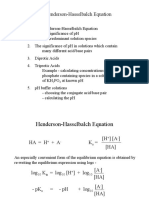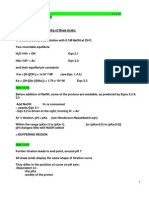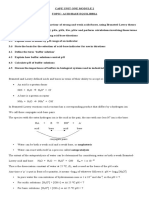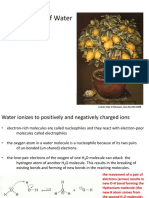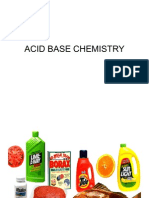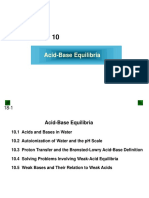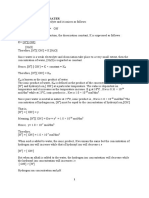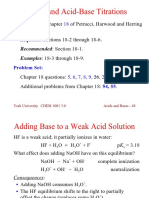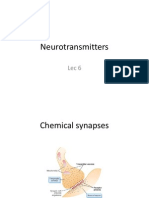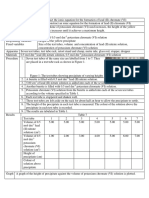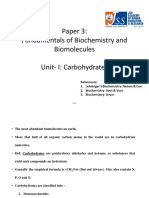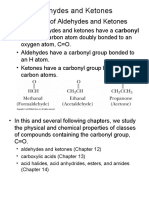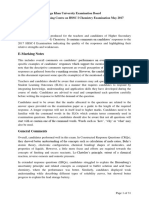Lecture 3 - PH
Lecture 3 - PH
Uploaded by
api-249972919Copyright:
Available Formats
Lecture 3 - PH
Lecture 3 - PH
Uploaded by
api-249972919Original Title
Copyright
Available Formats
Share this document
Did you find this document useful?
Is this content inappropriate?
Copyright:
Available Formats
Lecture 3 - PH
Lecture 3 - PH
Uploaded by
api-249972919Copyright:
Available Formats
www.chem4kids.
com
Dr. DialaAbu-Hassan, DDS, PhD
Dr.abuhassand@gmail.com
Lecture 3
MD summer 2014
1 Dr. Diala Abu-Hassan
pH
Outline
pH
Henderson-Hasselbalch Equation
Monoprotic and polyprotic acids
Titration
Dr. Diala Abu-Hassan 2
pH = -log
10
[H
+
]
Measuring the acidity of solutions, pH
Garrett et al
3
Dr. Diala Abu-Hassan
Garrett et al
The pH scale is a logarithmic
scale.
One pH unit difference implies a
10-fold difference in [H+].
Example: lemon juice at pH 2.0
contains more than 100 times as
much H+as orange juice at pH
4.0
4 Dr. Diala Abu-Hassan
pH
Measuring acidity in aqueous solutions- pH scale
pH = - log [H
3
O
+
]
[H
3
O
+
] = 10
-pH
Example 1: [H
3
O
+
] in household bleach is 10
-12
M
pH = - log [10
-12
] = 12
Example 2: Orange juice has a pH of 4
[H
3
O
+
] = 10
-4
M
Example 1:
What is the pH of a solution whose hydrogen ion
concentration is 3.2 x 10
4
mol/L?
pH= -log [H
+
]
= -log (3.2 x 10
-4
)
= -log (3.2) log (10
-4
)
= -0.5 + 4.0
= 3.5
pH problem solving
6 Dr. Diala Abu-Hassan
Acidic = more H+
Basic = more OH
-
7 Dr. Diala Abu-Hassan
Acids
Neutral
Bases
pH in solutions
Strong Acids and pH
HCl H
+
+ Cl
-
Ka = [H
+
] [Cl
-
]
[HCl]
[H
+
] = [acid]
Ex.1 M solution of HCl has a pH of
1 mM HCl solution has a pH of
0
0.1 M NaOH solution has a pH of
3
13
8
Dr. DialaAbu-Hassan
K
w
= [H
+
] [OH
-
] = 10
-14
Valid for acidic, basic, neutral and pure H
2
O
pH = - log [H
+
]
pOH = - log [OH
-
]
pH + pOH = 14
Dissociation of water
Example: A solution has an [OH
-
] = 10
-9
M
[H
3
O
+
] = 10
-5
M pH = 5
10 Dr. Diala Abu-Hassan
pH scale for some common substances
Campbell 6
th
edition
Enzyme activity and pH
11
Dr. Diala Abu-Hassan
12
Example:
Find the K
a
of a 0.04 M weak acid HA whose pH is 4.0?
K
a
= [A
-
] [H
+
] / [HA] = [H
+
]
2
/ [HA] = 10
-4
x10
-4
/ 0.04 = 2.5 x 10
-7
HA H
+
+ A
-
Example 2:
What is the pH of a 0.05 M Ba(OH)
2
?
[OH
-
] = 2x 0.05 = 0.10 M = 1 x 10
-1
pOH = - log 1 x 10
-1
= 1
pH= 14-1 = 13
[H
+
] = 1x 10
-13
Ba(OH)
2
Ba + 2OH
-
Remember pOH = -log [OH
-
]
Dr. Diala Abu-Hassan
13
Example:
The K
b
for ammonia is 1.8 x 10
-5
M. What is the pH of 1 x 10
-2
M of ammonia?
K
b
= [NH
4
+
] [OH
-
] / [NH
3
]
1.8 x 10
-5
= [OH
-
]
2
/ 0.01
[OH
-
] = 4.24 x 10
-4
M
pOH = -log 4.24 x 10
-4
= 3.37
pH = 14 - 3.37 = 10.63
NH
3
+ H
2
O NH
4
+
+ OH
-
Dr. Diala Abu-Hassan
Henderson-Hasselbalch Equation
The dissociation of a weak acid is as follows:
The acid dissociation constant is as follows:
Rearranging this expression in terms of the parameter
of interest [H+] gives the following:
HA H
+
+A
-
K
a
=
[H
+
][A
-
]
[HA]
K
a
[H
+
] =
[HA]
[A
-
]
14 Dr. Diala Abu-Hassan
Henderson-Hasselbalch Equation
Take the log of both sides:
log K
a
+ log log[H
+
] =
[HA]
[A
-
]
Change the signs , remember pK
a
= -log K
a
:
pK
a
- log
pH =
[HA]
[A
-
]
pK
a
+ log
pH =
[A
-
]
[HA]
or
15 Dr. Diala Abu-Hassan
pH = pKa
pH < pKa
pH > pKa
pH= pKa -1
pH=pKa + 1
What happens when ..
Substance protonation and deprotanation are in equillibruim.
H
+
on, substance protonated
H
+
off, substance deprotonated
Base/acid = 0.1
Base/acid = 10
16
Dr. DialaAbu-Hassan
17
Monoprotic- and PolyproticAcids
1. Monoprotic acids have only one ionizable proton.
2. Polyprotic acids have more than one ionizable proton.
3. The protons are removed in steps, not all at once.
CH
3
COOH + NaOH CH
3
COO
-
Na
+
+ H
2
O
H
3
PO
4
H
2
PO
4
-
HPO
4
-2
PO
4
-3
+ + +
H
+
H
+
H
+
pK
a1
=2.14
pK
a2
=7.20 pK
a3
=12.4
Dr. Diala Abu-Hassan
Polyprotic Acids
18 Dr. Diala Abu-Hassan
Sulfuric acid is a strong acid in its first dissociation step
and a weak acid in its second step.
H
2
SO
4
(aq) H
+
(aq) + HSO
4
(aq) K
a1
1.0x10
2
HSO
4
(aq) H
+
(aq) + SO
4
2
(aq) K
a2
1.2x10
-2
Polyprotic Acids
It is always easier to remove the first proton in a
polyprotic acid than the second. That is, K
a1
> K
a2
> K
a3
19 Dr. Diala Abu-Hassan
A plot of the fractions of H
2
CO
3
, HCO
-
3
and CO
3
2-
At pH = 9.00 H
2
CO
3
0%, HCO
-
3
= 95%and CO
3
2-
= 5%
At pH = 10.00 H
2
CO
3
0%, HCO
-
3
= 68%and CO
3
2-
= 32%
20 Dr. Diala Abu-Hassan
K
a1
=4.3 x10
-7
K
a2
=4.8 x10
-11
21
Titration
Dr. Diala Abu-Hassan
Titration is an experiment in which measured amounts of
base are added to a measured amount of acid while
following up changes in pH using a pH meter.
22
Titration curves
Dr. Diala Abu-Hassan
[CH
3
COOH] =[CH
3
COO
-
]
CH
3
COOH + OH
-
CH
3
COO
-
+ H
2
O
In the region small pH changes
upon addition of acid or base, the
acid/base ratio varies within a
narrow range (10:1 at one end
and 1:10 at the other end ).
pH =pK
a
Inflection point
The point in the titration at which
the acid is exactly neutralized is
called the equivalence point.
Titration curves
Once OH
-
is added to the
reaction, it reacts completely with
HA to form A
-
x = the equivalents of OH
-
added
V represents the volume of the
solution.
[A
-
] =
x
V
[HA] =
V
[Base]
[HA
i
]-[Base]
( )
23 Dr. Diala Abu-Hassan
pK
a
pK
a
pK
a
pK
a
+ log
pH =
[HA
i
]-[Base]
Dr. Diala Abu-Hassan 24
Example:
Calculate the relative amounts of acetic acid and acetate ion
present and pH values when 1 mol of acetic acid is titrated with
sodium hydroxide.
0.1 mol of NaOH is added
When 0.1 mol of NaOH is added, 0.1 mol of acetic acid reacts
with it to form 0.1 mol of acetate ion, leaving 0.9 mol of acetic
acid. The composition is 90% acetic acid and 10% acetate ion.
pH = pKa + log 0.1/0.9
pH = 4.76 + log 0.1/0.9
pH = 4.76 - 0.95
pH = 3.81
CH
3
COOH + OH
-
CH
3
COO
-
+ H
2
O
Dr. Diala Abu-Hassan 25
http://www.nd.edu/
Titration curve of Glycine
Equivalents of OH
-
added
Dr. Diala Abu-Hassan 26
You might also like
- J of Separation Science - 2012 - Hahn - Methods For Characterization of Biochromatography MediaDocument32 pagesJ of Separation Science - 2012 - Hahn - Methods For Characterization of Biochromatography MediaMarco RossiNo ratings yet
- 8 Buffer Calculation 0Document31 pages8 Buffer Calculation 0Ahmed ZakyNo ratings yet
- 03 - Chemical Properties of WaterDocument28 pages03 - Chemical Properties of WateryuouNo ratings yet
- 18 AbequilDocument29 pages18 AbequilSam H. SalehNo ratings yet
- 12271886Document32 pages12271886Daniela AbarcaNo ratings yet
- Henderson Hasslebach PDFDocument21 pagesHenderson Hasslebach PDFJesseca Calaunan QuintoNo ratings yet
- Expt 1 PH MeasurementDocument33 pagesExpt 1 PH MeasurementColene MoresNo ratings yet
- 8.3 THE PH SCALEDocument26 pages8.3 THE PH SCALECLAIR OsiasNo ratings yet
- PH Dan Larutan PenyanggaDocument38 pagesPH Dan Larutan PenyanggaSri Novita YandaNo ratings yet
- 3811 Polyprotic Acids WanswersDocument2 pages3811 Polyprotic Acids WanswersStephanie LeeNo ratings yet
- Uabs Acid Bases BufferDocument24 pagesUabs Acid Bases BufferJoseph blessingNo ratings yet
- LU 5 Acid Base EquilibriaDocument38 pagesLU 5 Acid Base Equilibriamynameisjohn081No ratings yet
- Kimia Untuk Teknik Sipil: 3 Sks - Semester 1 (Wajib)Document51 pagesKimia Untuk Teknik Sipil: 3 Sks - Semester 1 (Wajib)Jimmy LauNo ratings yet
- BuffersDocument5 pagesBuffersDiana ZhangNo ratings yet
- Chapter 18 Acids and Bases Week 1Document22 pagesChapter 18 Acids and Bases Week 1Zenonissya Galwan BataraNo ratings yet
- Quantitative: Analytical Chemistry (Qualitative and Chemistry)Document13 pagesQuantitative: Analytical Chemistry (Qualitative and Chemistry)Rizza OlivaNo ratings yet
- Analytical Chemistry ReviewDocument43 pagesAnalytical Chemistry ReviewrbytesNo ratings yet
- BuffersDocument24 pagesBufferscazeyfetalinoNo ratings yet
- PHCM223 Midterm Revision SS16 443Document20 pagesPHCM223 Midterm Revision SS16 443Michelle MenciasNo ratings yet
- Material PHDocument19 pagesMaterial PHrazAn swNo ratings yet
- Ionic Equilibria Acids and Bases NotesDocument21 pagesIonic Equilibria Acids and Bases Notesseanapollomarco.cantosNo ratings yet
- Lecture Notes 3A 3502 2005-06 Slide 3A-01: (See Eqn. 1.4 B)Document8 pagesLecture Notes 3A 3502 2005-06 Slide 3A-01: (See Eqn. 1.4 B)Neha MehraNo ratings yet
- H3PO4Document12 pagesH3PO4Je RivasNo ratings yet
- CAPE UNIT ONE MODULE 2 Acid Base Equlibria Hand OutDocument7 pagesCAPE UNIT ONE MODULE 2 Acid Base Equlibria Hand OutLisa SawhNo ratings yet
- Buffers NEWDocument29 pagesBuffers NEWaselabs345No ratings yet
- Acids & Bases Lecture NotesDocument51 pagesAcids & Bases Lecture NotesTahir Hussain100% (1)
- Chapter 14 NotesDocument12 pagesChapter 14 NotesBofeng Kibby ChenNo ratings yet
- Biochem Lab 1Document108 pagesBiochem Lab 1Chem PanganibanNo ratings yet
- Acids and BasesDocument70 pagesAcids and BasesChery-an PletNo ratings yet
- Chapter 19 Acids and Bases PPT Glembocki 2017Document32 pagesChapter 19 Acids and Bases PPT Glembocki 2017Master NistroNo ratings yet
- Lecture 5 - Acid Base ConceptsDocument27 pagesLecture 5 - Acid Base ConceptsThomas JonesNo ratings yet
- s15 Miller Chap 2b Lecture 1Document22 pagess15 Miller Chap 2b Lecture 1himanshu sihagNo ratings yet
- Study Guide 10 DraftDocument5 pagesStudy Guide 10 DraftDominador RomuloNo ratings yet
- 18 silberberg8eISMChapter18 9eDocument68 pages18 silberberg8eISMChapter18 9efgb9qfb7x6No ratings yet
- Lecture 2 - Acid-Base Chemistry & BuffersDocument9 pagesLecture 2 - Acid-Base Chemistry & Buffersaatrrisdal2026No ratings yet
- Acids Bases NOTESDocument27 pagesAcids Bases NOTESsanele50% (2)
- Z0217002012017408710 - Acid and Bases - Revision 1Document44 pagesZ0217002012017408710 - Acid and Bases - Revision 1joenni hansNo ratings yet
- Biochem. ReviewerDocument34 pagesBiochem. ReviewerHara Jane TobiasNo ratings yet
- LifeScience I Week 1 Topic 2Document28 pagesLifeScience I Week 1 Topic 2nsemn1234No ratings yet
- Exemple Sours and ExercicesDocument9 pagesExemple Sours and ExercicesDriss EL FadilNo ratings yet
- Acid BaseDocument63 pagesAcid BaseFrian LiaNo ratings yet
- Biochemistry of PH and BuffersDocument13 pagesBiochemistry of PH and BuffersWally I. TapasNo ratings yet
- A2 Test 8 Notes - Acids, Bases and BuffersDocument7 pagesA2 Test 8 Notes - Acids, Bases and BuffersJane PernesNo ratings yet
- PH Calculations: Brønsted-Lowry Concept of Acids and BasesDocument16 pagesPH Calculations: Brønsted-Lowry Concept of Acids and BasesNoura ANo ratings yet
- Ch10 LectureDocument53 pagesCh10 LectureaikatNo ratings yet
- Water and PHDocument17 pagesWater and PHLea TanNo ratings yet
- Acid-Base EquilbriaDocument67 pagesAcid-Base EquilbriaKaela Beatrice Sy LatoNo ratings yet
- 8.3 The PH ScaleDocument22 pages8.3 The PH Scalelobna masadehNo ratings yet
- Chapter 16 Powerpoint - Student VersionDocument141 pagesChapter 16 Powerpoint - Student Versionroshni rNo ratings yet
- 100L Lecture 3 Ionic Product of WaterDocument4 pages100L Lecture 3 Ionic Product of WaterMichael EhondorNo ratings yet
- Asam BasaDocument25 pagesAsam BasaFitriHdynNo ratings yet
- Acid Base EquilibriaDocument4 pagesAcid Base EquilibriarbytesNo ratings yet
- Notes-Acids and BasesDocument9 pagesNotes-Acids and Baseshyun0124No ratings yet
- Lecture 2Document34 pagesLecture 2Abo dahabNo ratings yet
- 14 Acids, Bases and SaltsDocument105 pages14 Acids, Bases and Saltsmika yzobelNo ratings yet
- Acid and BaseDocument32 pagesAcid and BaseSachin SinghNo ratings yet
- CHEM1001 Acid Base Part 2Document36 pagesCHEM1001 Acid Base Part 2Dlcm Born To WinNo ratings yet
- Acids BasesDocument6 pagesAcids Basesthis_is_m3No ratings yet
- Tutorial 6 - Acids and BasesDocument14 pagesTutorial 6 - Acids and BasesdeanNo ratings yet
- Lecture 5 - Buffers II 1Document14 pagesLecture 5 - Buffers II 1api-249972919No ratings yet
- Lec 6Document11 pagesLec 6api-249972919No ratings yet
- Embryo Edited 2ed LectureDocument17 pagesEmbryo Edited 2ed Lectureapi-249972919No ratings yet
- Lecture 2 - WaterDocument27 pagesLecture 2 - Waterapi-249972919No ratings yet
- General Arrangement of The Abdominal VisceraDocument30 pagesGeneral Arrangement of The Abdominal Visceraapi-249972919100% (2)
- Lec 11 1Document5 pagesLec 11 1api-249972919No ratings yet
- Cardiac Muscle Physiology - StudentsDocument25 pagesCardiac Muscle Physiology - Studentsapi-249972919No ratings yet
- First and Second Week of DevelopmentDocument18 pagesFirst and Second Week of Developmentapi-249972919No ratings yet
- MediastinumDocument24 pagesMediastinumapi-249972919100% (1)
- Lec 12Document17 pagesLec 12api-249972919No ratings yet
- Lec 7Document11 pagesLec 7api-249972919No ratings yet
- Lec 10Document9 pagesLec 10api-249972919No ratings yet
- DR Mohtaseb Slide 16 Embryology 7Document32 pagesDR Mohtaseb Slide 16 Embryology 7api-249972919No ratings yet
- DR Khatatbeh 2 Lec 5Document29 pagesDR Khatatbeh 2 Lec 5api-249972919No ratings yet
- ThoraxDocument29 pagesThoraxapi-249972919No ratings yet
- Lec 5Document13 pagesLec 5api-249972919No ratings yet
- The ForearmDocument26 pagesThe Forearmapi-249972919No ratings yet
- Membrane Pot2Document22 pagesMembrane Pot2api-249972919No ratings yet
- DR Faisal 1Document22 pagesDR Faisal 1api-249972919No ratings yet
- DR Khatatbeh 1 Lec 4Document38 pagesDR Khatatbeh 1 Lec 4api-249972919No ratings yet
- Exogenic Processes or Denudation: 2 Semester: Earth ScienceDocument5 pagesExogenic Processes or Denudation: 2 Semester: Earth ScienceLeshauna CaleighNo ratings yet
- Soil MineralsDocument27 pagesSoil MineralsSumi SubiNo ratings yet
- Continuous Variation MethodDocument2 pagesContinuous Variation MethodplyanaNo ratings yet
- Arabian Journal Chemistry 2023Document16 pagesArabian Journal Chemistry 2023Dr Noor Haida Mohd KausNo ratings yet
- Oxid Numb AnsDocument3 pagesOxid Numb AnsUday Prakash Sahu100% (2)
- Haritsons Mintech Private LimitedDocument10 pagesHaritsons Mintech Private Limitedsoumyarm942No ratings yet
- Paper 3 Unit 1 Carbohydrates-RRADocument35 pagesPaper 3 Unit 1 Carbohydrates-RRAshabanaNo ratings yet
- International StandardDocument14 pagesInternational StandardTheAnh TranNo ratings yet
- Session 1 - Polymer Mechanical & Other Testing - 18march2017 - SwapnilDocument67 pagesSession 1 - Polymer Mechanical & Other Testing - 18march2017 - SwapnilSwapnil Ahire (APPL-HIN)No ratings yet
- XII Chemistry Study Materials Class XII 28.10.2022Document318 pagesXII Chemistry Study Materials Class XII 28.10.2022THULASISANJEEV SNo ratings yet
- Longest WordsDocument4 pagesLongest WordsJenny A. JamesNo ratings yet
- Determination of Water TurbidityDocument3 pagesDetermination of Water TurbidityawaaanNo ratings yet
- Naming Compounds Practice WorksheetDocument5 pagesNaming Compounds Practice Worksheetd4ddY chiLLNo ratings yet
- 8 Strand PolypropyleneDocument1 page8 Strand Polypropylenedhana_benzNo ratings yet
- Structure of Aldehydes and KetonesDocument42 pagesStructure of Aldehydes and KetonesPaul Jhon EugenioNo ratings yet
- Nanoemulsions and Topical Creams For The Safe and Effective Delivery of Lipophilic Antioxidant Coenzyme Q10Document24 pagesNanoemulsions and Topical Creams For The Safe and Effective Delivery of Lipophilic Antioxidant Coenzyme Q10Raghavendra NaveenNo ratings yet
- RhodiumDocument13 pagesRhodiumBORUTO ANIMEZONENo ratings yet
- Capstone EnviDocument27 pagesCapstone EnviNicole ValmonteNo ratings yet
- Complexation and Protein BindingDocument15 pagesComplexation and Protein BindingShivraj JadhavNo ratings yet
- Analysis of Synthetic Polymers: Chem.Document23 pagesAnalysis of Synthetic Polymers: Chem.Ricky EstepaNo ratings yet
- Wool FatDocument4 pagesWool FataymenbiogalenicNo ratings yet
- E-Marking Notes On Chemistry HSSC I May 2017Document31 pagesE-Marking Notes On Chemistry HSSC I May 2017alizaahsan36No ratings yet
- British Standard 1710 Pipe Marker Locations: BS 1710 Basic Identification ColoursDocument3 pagesBritish Standard 1710 Pipe Marker Locations: BS 1710 Basic Identification ColoursgaborodcNo ratings yet
- Kuliah 2.ionik MDocument34 pagesKuliah 2.ionik MRusli NurdinNo ratings yet
- Recent Advances in Liquid Chromatography Analysis of Synthetic PolymersDocument280 pagesRecent Advances in Liquid Chromatography Analysis of Synthetic PolymersAnderson CarvalhoNo ratings yet
- Sicho 2013 Question PaperDocument4 pagesSicho 2013 Question PaperKunda.Satyanarayana100% (1)
- Homework Chapter 10Document3 pagesHomework Chapter 10Zac75% (4)
- Ts SR Chemistry Imp Questions 2023-24Document6 pagesTs SR Chemistry Imp Questions 2023-24pandu2006goudNo ratings yet
- Cbjesccq04 PDFDocument17 pagesCbjesccq04 PDFAbhishek Kumar VermaNo ratings yet





